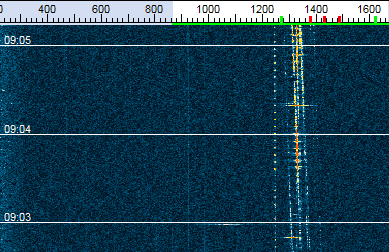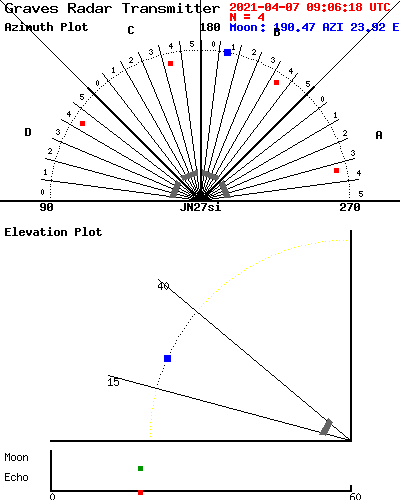Graves Radar Update April 2021
(2021-04-08) PE1ITR
In 2007 I wrote about the Graves bi-static radar system at 143.050 MHz. More about this on this page. The radar pattern was then described, but recent observations show that this is no longer correct. Reason to revisit it.
Every now and then I use Graves to receive the moon echoes and improve my receiver.
Sequence
It turns out that the Graves beams have started spinning faster. The sequence is now 0.8 second.
I adjusted the animation accordingly. As far as I can see the timing of the sequence is based on unix time. The php function microtime() returns the number of seconds to 6 decimal places since 1970-01-01 00:00:00. This is necessary because accuracy is required within a second.
$n is the subsector in which direction is broadcast. There are 6 subsectors per sector. This gives the following formula applied in the php animation:
$n = ((microtime(true)/0.8)%(86400/0.8))%6;
The picture below shows Graves' reflections. The lunar reflections is the dashed line at about 1240 Hz. The set of lines at 1320 Hz are plane reflections. There are an average of 12 reflections in 1 minute. 60 s / 12 = 4.8 second for 1 cycle within a sector. There are 6 sub sectors. 4.8 / 6 = 0.8 second for 1 sub sector.

Software adjustments in the animation
In addition to the adjustment described above, the position of the moon is now also displayed by means of a blue point. This only when the moon is above the horizon and when my satellite tracking program is running on the server.
This way you can see when the beams are emitting towards the moon.
An extra window has been added at the bottom of the image. When the beam is pointing towards the moon, a blue dot appears. When the moon echo reaches Earth and is received, a green dot appears. Given the distance between Earth and the Moon and back again, the radio signal takes 2.5 seconds. So the echo arrives at the receiver about 2.5 seconds later.

Real time animation
HOME | Go Back

